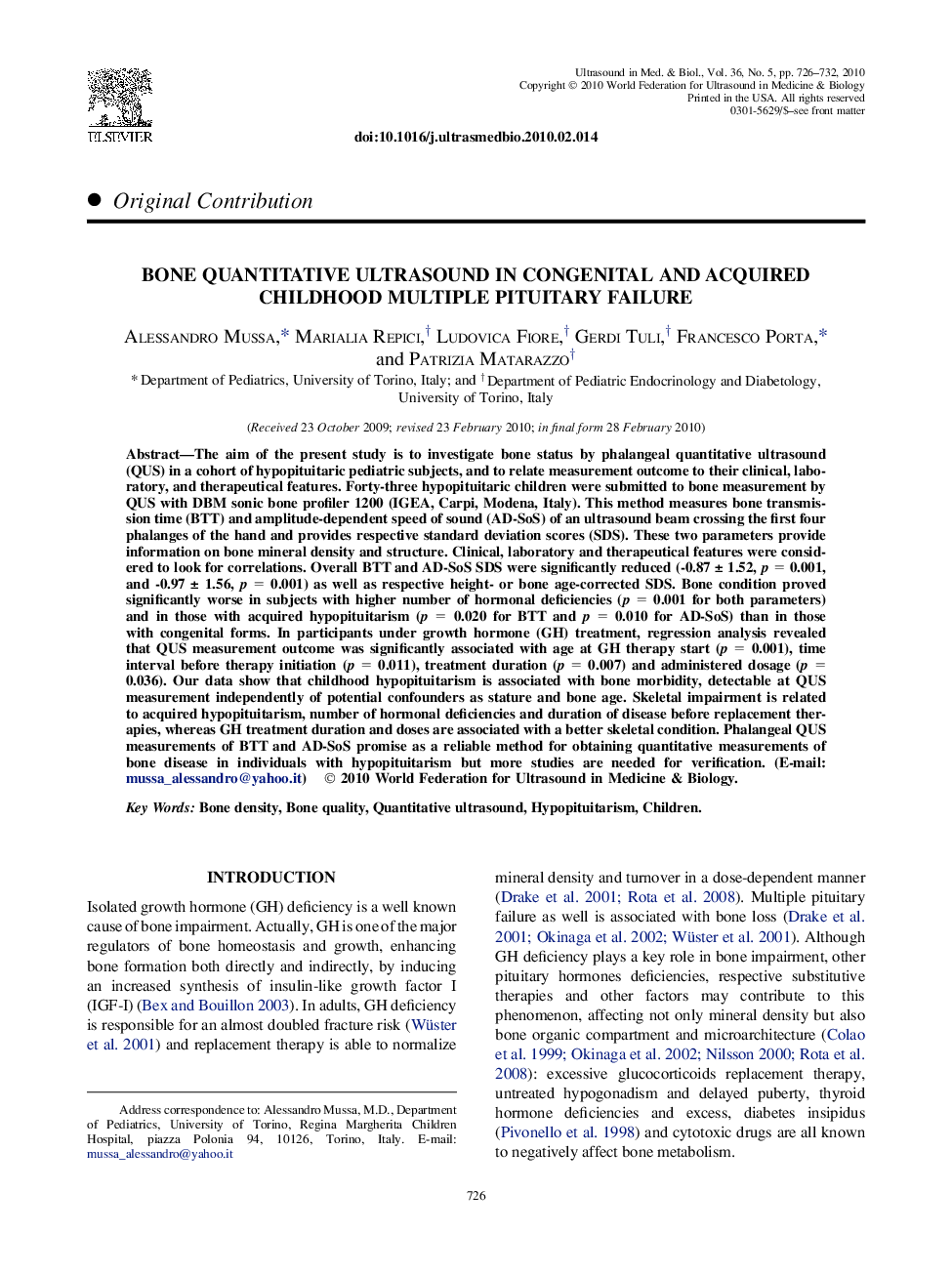| کد مقاله | کد نشریه | سال انتشار | مقاله انگلیسی | نسخه تمام متن |
|---|---|---|---|---|
| 1761310 | 1019641 | 2010 | 7 صفحه PDF | دانلود رایگان |
عنوان انگلیسی مقاله ISI
Bone Quantitative Ultrasound in Congenital and Acquired Childhood Multiple Pituitary Failure
دانلود مقاله + سفارش ترجمه
دانلود مقاله ISI انگلیسی
رایگان برای ایرانیان
کلمات کلیدی
موضوعات مرتبط
مهندسی و علوم پایه
فیزیک و نجوم
آکوستیک و فرا صوت
پیش نمایش صفحه اول مقاله

چکیده انگلیسی
The aim of the present study is to investigate bone status by phalangeal quantitative ultrasound (QUS) in a cohort of hypopituitaric pediatric subjects, and to relate measurement outcome to their clinical, laboratory, and therapeutical features. Forty-three hypopituitaric children were submitted to bone measurement by QUS with DBM sonic bone profiler 1200 (IGEA, Carpi, Modena, Italy). This method measures bone transmission time (BTT) and amplitude-dependent speed of sound (AD-SoS) of an ultrasound beam crossing the first four phalanges of the hand and provides respective standard deviation scores (SDS). These two parameters provide information on bone mineral density and structure. Clinical, laboratory and therapeutical features were considered to look for correlations. Overall BTT and AD-SoS SDS were significantly reduced (-0.87 ± 1.52, p = 0.001, and -0.97 ± 1.56, p = 0.001) as well as respective height- or bone age-corrected SDS. Bone condition proved significantly worse in subjects with higher number of hormonal deficiencies (p = 0.001 for both parameters) and in those with acquired hypopituitarism (p = 0.020 for BTT and p = 0.010 for AD-SoS) than in those with congenital forms. In participants under growth hormone (GH) treatment, regression analysis revealed that QUS measurement outcome was significantly associated with age at GH therapy start (p = 0.001), time interval before therapy initiation (p = 0.011), treatment duration (p = 0.007) and administered dosage (p = 0.036). Our data show that childhood hypopituitarism is associated with bone morbidity, detectable at QUS measurement independently of potential confounders as stature and bone age. Skeletal impairment is related to acquired hypopituitarism, number of hormonal deficiencies and duration of disease before replacement therapies, whereas GH treatment duration and doses are associated with a better skeletal condition. Phalangeal QUS measurements of BTT and AD-SoS promise as a reliable method for obtaining quantitative measurements of bone disease in individuals with hypopituitarism but more studies are needed for verification. (E-mail: mussa_alessandro@yahoo.it)
ناشر
Database: Elsevier - ScienceDirect (ساینس دایرکت)
Journal: Ultrasound in Medicine & Biology - Volume 36, Issue 5, May 2010, Pages 726-732
Journal: Ultrasound in Medicine & Biology - Volume 36, Issue 5, May 2010, Pages 726-732
نویسندگان
Alessandro Mussa, Marialia Repici, Ludovica Fiore, Gerdi Tuli, Francesco Porta, Patrizia Matarazzo,